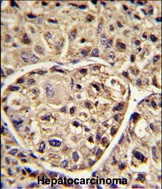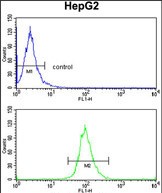ELOVL6 Antibody (N-term)
Purified Rabbit Polyclonal Antibody (Pab)
- SPECIFICATION
- CITATIONS
- PROTOCOLS
- BACKGROUND

Application
| FC, IHC-P, WB, E |
|---|---|
| Primary Accession | Q9H5J4 |
| Other Accession | Q920L6, Q920L5, Q5ZJR8 |
| Reactivity | Human, Mouse |
| Predicted | Chicken, Rat |
| Host | Rabbit |
| Clonality | Polyclonal |
| Isotype | Rabbit IgG |
| Calculated MW | 31376 Da |
| Antigen Region | 32-58 aa |
| Gene ID | 79071 |
|---|---|
| Other Names | Elongation of very long chain fatty acids protein 6, 3-keto acyl-CoA synthase ELOVL6, ELOVL fatty acid elongase 6, ELOVL FA elongase 6, Fatty acid elongase 2, hELO2, Fatty acyl-CoA elongase, Long-chain fatty-acyl elongase, Very-long-chain 3-oxoacyl-CoA synthase 6, ELOVL6, FACE, LCE |
| Target/Specificity | This ELOVL6 antibody is generated from rabbits immunized with a KLH conjugated synthetic peptide between 32-58 amino acids from the N-terminal region of human ELOVL6. |
| Dilution | FC~~1:10~50 IHC-P~~1:50~100 WB~~1:1000 E~~Use at an assay dependent concentration. |
| Format | Purified polyclonal antibody supplied in PBS with 0.09% (W/V) sodium azide. This antibody is prepared by Saturated Ammonium Sulfate (SAS) precipitation followed by dialysis against PBS. |
| Storage | Maintain refrigerated at 2-8°C for up to 2 weeks. For long term storage store at -20°C in small aliquots to prevent freeze-thaw cycles. |
| Precautions | ELOVL6 Antibody (N-term) is for research use only and not for use in diagnostic or therapeutic procedures. |
| Name | ELOVL6 {ECO:0000255|HAMAP-Rule:MF_03206} |
|---|---|
| Synonyms | FACE, LCE |
| Function | Catalyzes the first and rate-limiting reaction of the four reactions that constitute the long-chain fatty acids elongation cycle. This endoplasmic reticulum-bound enzymatic process allows the addition of 2 carbons to the chain of long- and very long-chain fatty acids (VLCFAs) per cycle. Condensing enzyme that elongates fatty acids with 12, 14 and 16 carbons with higher activity toward C16:0 acyl-CoAs. Catalyzes the synthesis of unsaturated C16 long chain fatty acids and, to a lesser extent, C18:0 and those with low desaturation degree. May participate in the production of saturated and monounsaturated VLCFAs of different chain lengths that are involved in multiple biological processes as precursors of membrane lipids and lipid mediators. |
| Cellular Location | Endoplasmic reticulum membrane {ECO:0000255|HAMAP-Rule:MF_03206, ECO:0000269|PubMed:20937905}; Multi- pass membrane protein {ECO:0000255|HAMAP-Rule:MF_03206} |
| Tissue Location | Ubiquitous.. |

Thousands of laboratories across the world have published research that depended on the performance of antibodies from Abcepta to advance their research. Check out links to articles that cite our products in major peer-reviewed journals, organized by research category.
info@abcepta.com, and receive a free "I Love Antibodies" mug.
Provided below are standard protocols that you may find useful for product applications.
Background
Fatty acid elongases (EC 6.2.1.3), such as ELOVL6, use malonyl-CoA as a 2-carbon donor in the first and rate-limiting step of fatty acid elongation.
References
Lu,Y., J. Lipid Res. 49 (12), 2582-2589 (2008)
If you have used an Abcepta product and would like to share how it has performed, please click on the "Submit Review" button and provide the requested information. Our staff will examine and post your review and contact you if needed.
If you have any additional inquiries please email technical services at tech@abcepta.com.













 Foundational characteristics of cancer include proliferation, angiogenesis, migration, evasion of apoptosis, and cellular immortality. Find key markers for these cellular processes and antibodies to detect them.
Foundational characteristics of cancer include proliferation, angiogenesis, migration, evasion of apoptosis, and cellular immortality. Find key markers for these cellular processes and antibodies to detect them. The SUMOplot™ Analysis Program predicts and scores sumoylation sites in your protein. SUMOylation is a post-translational modification involved in various cellular processes, such as nuclear-cytosolic transport, transcriptional regulation, apoptosis, protein stability, response to stress, and progression through the cell cycle.
The SUMOplot™ Analysis Program predicts and scores sumoylation sites in your protein. SUMOylation is a post-translational modification involved in various cellular processes, such as nuclear-cytosolic transport, transcriptional regulation, apoptosis, protein stability, response to stress, and progression through the cell cycle. The Autophagy Receptor Motif Plotter predicts and scores autophagy receptor binding sites in your protein. Identifying proteins connected to this pathway is critical to understanding the role of autophagy in physiological as well as pathological processes such as development, differentiation, neurodegenerative diseases, stress, infection, and cancer.
The Autophagy Receptor Motif Plotter predicts and scores autophagy receptor binding sites in your protein. Identifying proteins connected to this pathway is critical to understanding the role of autophagy in physiological as well as pathological processes such as development, differentiation, neurodegenerative diseases, stress, infection, and cancer.





